Patricio Grassini, UNL Associate Professor of Agronomy and Horticulture, Extension Cropping System Specialist and Water for Food Institute Fellow; Jose Andrade, UNL Affiliate; Juan Ignacio Rattalino Edreira, UNL Research Assistant Professor of Agronomy and Horticulture; Gonzalo Rizzo, UNL PhD student; Haishun Yang, UNL Associate Professor of Agronomy and Horticulture and Water for Food Institute Fellow; Keith Glewen & Jennifer Rees, Nebraska Extension Educators; Jeff Coulter, Professor and Extension Specialist, University of Minnesota; Mark Licht (Extension Cropping System Agronomist) & Sotirios Archontoulis (Assistant Professor), Iowa State University; Ignacio Ciampitti, Crop Production and Cropping System Specialist and Assistant Professor of Agronomy, Kansas State University; Ray Massey, Extension Professor, University of Missouri
Simulations of 2020 end-of-season corn yield potential and real-time crop stage were performed on July 14 for 40 locations across the US Corn Belt using the UNL Hybrid-Maize crop model in collaboration with faculty and extension educators from ten universities. This article summarizes the simulated crop stages and yield forecasts; the data can be found in Table 1 below. Details on the UNL Hybrid-Maize crop model and the underpinning methodology to simulate phenology and forecast end-of-season yields, as well as on interpretation and uses of yield forecasts, are described in a previous article. Note that one location in IA (Kanawha) was not included for the forecasts due to lack of weather data.
A summary of weather conditions during the last 60 days (from May 14 to July 13) is shown in Figure 1. The season started with warm conditions throughout the Corn Belt, showing average temperature above normal in most cases. In contrast, rainfall was more erratic, with most locations exhibiting near or above normal records, except for western KS and NE, eastern NE and western IA, and a few scattered locations in IL and IN with rainfall below normal.
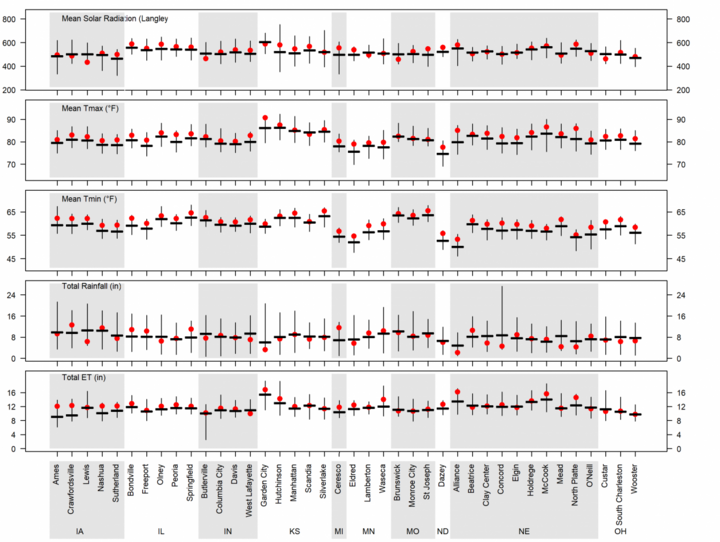
| Location | Water regime | Long-term average yield (bu/ac) § | Range of Yp forecasts as of Jul 14 (bu/ac)¶ 25th | Range of Yp forecasts as of Jul 14 (bu/ac)¶ 75th | Below (relative to the long-term Yp)† | Near (relative to the long-term Yp)† | Above (relative to the long-term Yp)† | Simulated current crop stage* | |
|---|---|---|---|---|---|---|---|---|---|
| NE | Alliance | Irrigated | 194 | 194 | 224 | 0% | 65% | 35% | V14 |
| Beatrice | Dryland | 143 | 81 | 136 | 63% | 13% | 23% | R1, Silking | |
| Irrigated | 230 | 218 | 248 | 3% | 73% | 23% | R1, Silking | ||
| Clay Center | Dryland | 153 | 48 | 121 | 87% | 11% | 3% | R1, Silking | |
| Irrigated | 245 | 238 | 264 | 5% | 74% | 21% | R1, Silking | ||
| Concord | Dryland | 172 | 125 | 203 | 45% | 26% | 29% | V18 | |
| Irrigated | 248 | 245 | 283 | 3% | 61% | 37% | V18 | ||
| Elgin | Irrigated | 252 | 241 | 276 | 3% | 72% | 25% | V16 | |
| Holdrege | Dryland | 109 | 58 | 129 | 47% | 16% | 38% | R1, Silking | |
| Irrigated | 242 | 229 | 264 | 9% | 75% | 16% | V18 | ||
| McCook | Dryland | 84 | 36 | 86 | 63% | 13% | 24% | R1, Silking | |
| 225 | 211 | 243 | 13% | 74% | 13% | V18 | |||
| Mead | Dryland | 177 | 110 | 154 | 79% | 16% | 5% | V18 | |
| Irrigated | 235 | 222 | 256 | 8% | 71% | 21% | R1, Silking | ||
| North Platte | Dryland | 86 | 38 | 93 | 53% | 24% | 24% | V16 | |
| Irrigated | 235 | 225 | 263 | 11% | 58% | 32% | V16 | ||
| O'Neill | Irrigated | 227 | 216 | 250 | 9% | 63% | 29% | V14 | |
| IA | Ames | Dryland | 231 | 204 | 238 | 28% | 56% | 16% | R1, Silking |
| Crawfordsville | Dryland | 228 | 229 | 250 | 7% | 70% | 23% | R1, Silking | |
| Lewis | Dryland | 205 | 169 | 213 | 55% | 32% | 14% | V18 | |
| Nashua | Dryland | 230 | 223 | 250 | 6% | 74% | 19% | V16 | |
| Sutherland | Dryland | 210 | 189 | 225 | 23% | 55% | 23% | V16 | |
| IL | Bondville | Dryland | 228 | 211 | 251 | 18% | 57% | 25% | V18 |
| Freeport | Dryland | 209 | 217 | 256 | 3% | 47% | 50% | V16 | |
| Olney | Dryland | 180 | 133 | 190 | 47% | 43% | 10% | R1, Silking | |
| Peoria | Dryland | 204 | 193 | 222 | 4% | 78% | 19% | R1, Silking | |
| Springfield | Dryland | 166 | 166 | 202 | 15% | 35% | 50% | R1, Silking | |
| IN | Butlerville | Dryland | 224 | 202 | 229 | 24% | 59% | 18% | V18 |
| Columbia City | Dryland | 221 | 201 | 244 | 24% | 47% | 29% | V16 | |
| Davis | Dryland | 227 | 226 | 245 | 0% | 100% | 0% | V16 | |
| West Lafayette | Dryland | 235 | 230 | 247 | 6% | 82% | 12% | V18 | |
| KS | Garden City | Irrigated | 219 | 205 | 231 | 21% | 68% | 12% | R2, Blister |
| Hutchinson | Dryland | 90 | 57 | 108 | 60% | 7% | 33% | R3, Milk | |
| Manhattan | Dryland | 128 | 114 | 166 | 26% | 20% | 54% | R2, Blister | |
| Scandia | Dryland | 122 | 82 | 150 | 56% | 15% | 29% | R1, Silking | |
| Irrigated | 224 | 214 | 259 | 6% | 59% | 35% | V18 | ||
| Silverlake | Dryland | 129 | 126 | 165 | 15% | 29% | 56% | R2, Blister | |
| Irrigated | 209 | 186 | 218 | 29% | 59% | 12% | R2, Blister | ||
| MI | Ceresco | Dryland | 178 | 191 | 241 | 11% | 21% | 68% | V12 |
| MN | Eldred | Dryland | 104 | 128 | 160 | 0% | 8% | 92% | V12 |
| Lamberton | Dryland | 206 | 209 | 236 | 0% | 39% | 61% | V16 | |
| Waseca | Dryland | 214 | 217 | 253 | 8% | 52% | 40% | V16 | |
| MO | Brunswick | Dryland | 178 | 123 | 188 | 50% | 30% | 20% | R1, Silking |
| Monroe City | Dryland | 163 | 143 | 230 | 32% | 16% | 53% | V18 | |
| St Joseph | Dryland | 159 | 145 | 184 | 25% | 40% | 35% | R1, Silking | |
| ND | Dazey | Dryland | 106 | 68 | 145 | 52% | 8% | 40% | V10 |
| OH | Custar | Dryland | 204 | 186 | 211 | 23% | 71% | 6% | V16 |
| South Charleston | Dryland | 207 | 158 | 209 | 51% | 40% | 9% | V16 | |
| Wooster | Dryland | 208 | 192 | 229 | 14% | 60% | 26% | V14 |
§Long-term (last 20+ years) potential yield at each location and surrounding area.
¶ Range of forecasted 2020 potential yields based on average planting date in 2020, indicating the potential yields in the 25th and 75th percentile of the potential yield distribution (associated with respective adverse and favorable weather scenarios during the rest of the season).
† Probability of obtaining a 2020 yield below (10%) than the long-term potential yield at each location.
Simulated Corn Stage Across 40 Locations
Corn has reached silking in most of the southern fringe of the Corn Belt, including sites in southern NE and IA, western MO and IL, and KS. In contrast, majority of sites in the northern and eastern fringe of the region are still in the late vegetative phases (ND, MN, northern IA and IL, MI, IN, and OH) as well as in northern and western NE (Figure 2). Most locations are running ahead last year’s corn development.
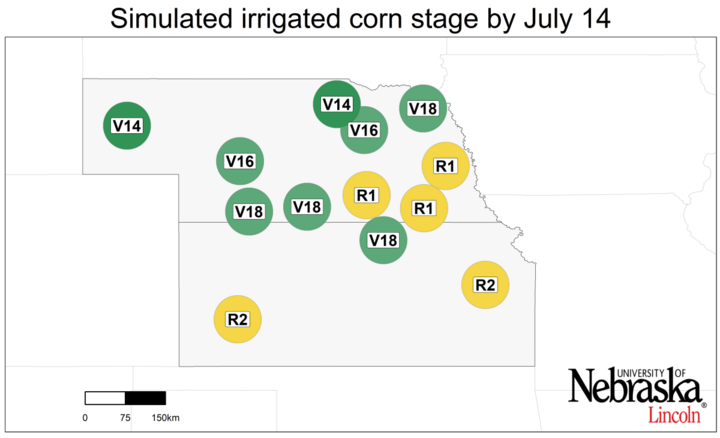
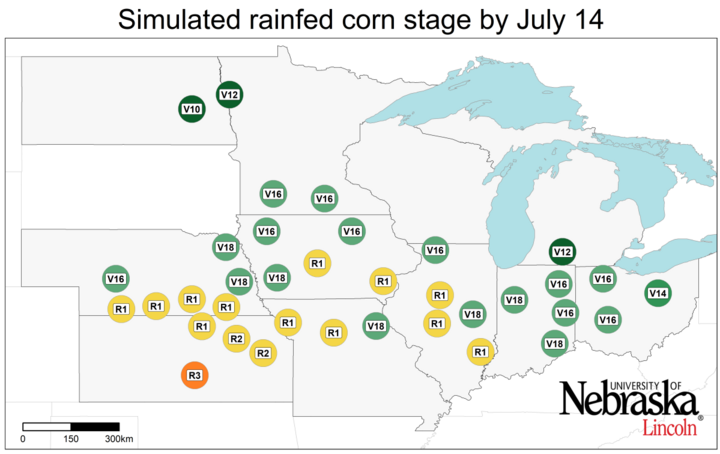
Irrigated Corn: High Probability of Near-Average Yields
The range of forecasted irrigated corn yield potential for each location, as well as the probabilities for yields above, near, or below average, are shown in Figures 3 and 4. Although it is still too early in the season, there is a relatively high probability of near-average yields for all sites. Weather conditions during the rest of the growing season will determine if most irrigated sites will have near-average yield potential. The chance of below-average yield appears to be small for all irrigated sites except for one site (Silverlake, KS). Compared with the 2019 forecasts by mid-July, the forecasted scenario for irrigated maize seems more pessimistic in the current season.
Variable 2020 Forecasted Corn Yield Across Rainfed Locations
Forecasted yield potential is highly variable across rainfed sites (Figures 3 and 4). There is a high probability of below-average yield (>75%, that is, a chance of 3 out of 4) at two sites in south-central and eastern NE, while there is only one site with high probability of above-average yield (Eldred, MN). Overall, at this point of the season, probability of near-average yield is relatively high in the central area of the Corn Belt (southern MN, IA, IL, and IN). In contrast, the probability of below-average yields increases towards the western fringe of the region (NE, KS, and southwestern IA) but this may change depending on precipitation and temperature during the rest of July and August. Compared with the 2019 forecasts by mid-July, the forecasted scenario for rainfed maize seems more pessimistic in the western fringe of the Corn Belt (southwestern IA, NE, KS, and ND) in the current season. In the remaining area, the scenario looks similar to last year’s forecast at this point in the season.
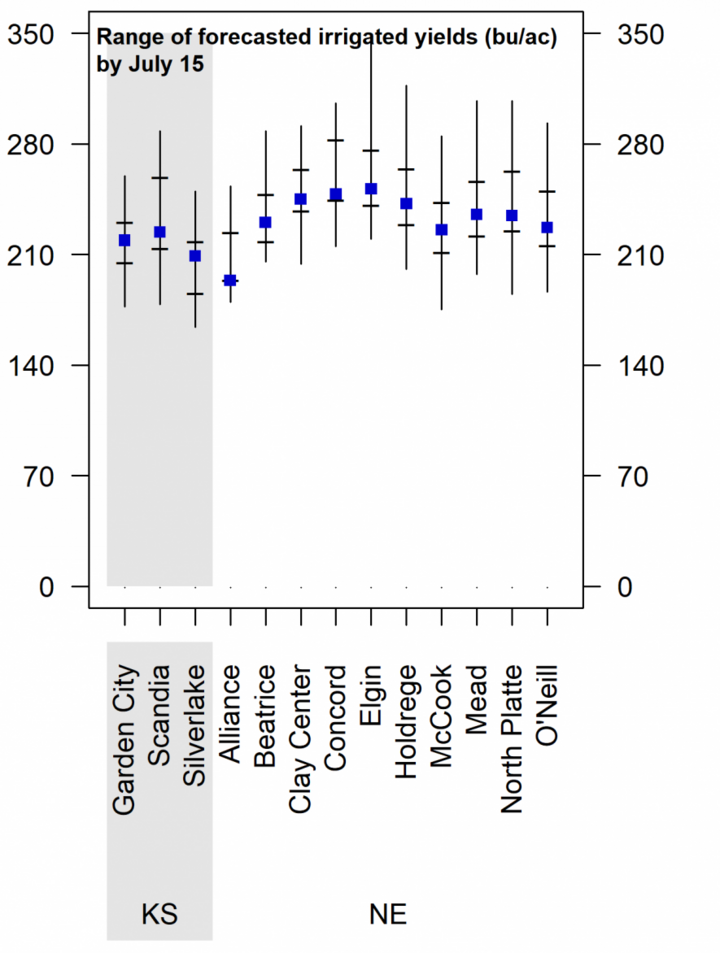
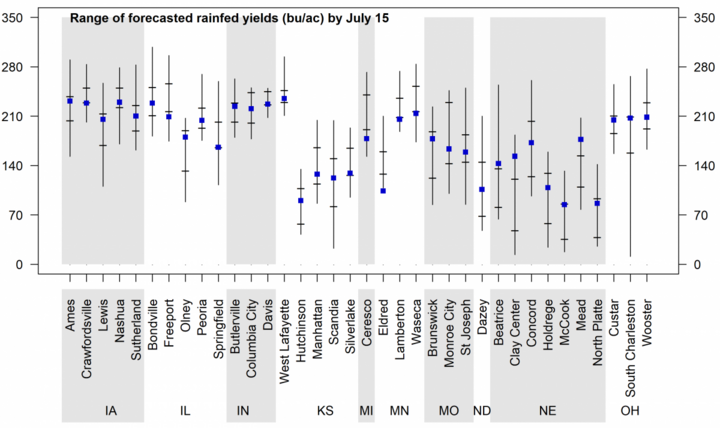

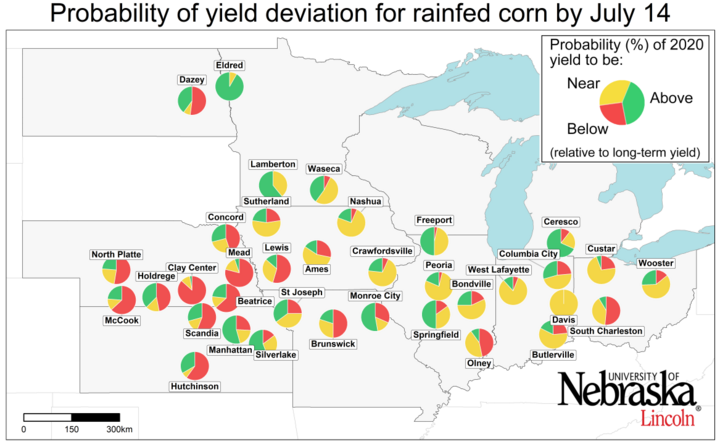
Conclusions
Corn is still in vegetative stages throughout most of the region. Although it is still too early to make strong inferences about end-of-season yields for irrigated corn, there is a relatively high probability for near-average yields for a majority of sites, but this can change depending upon temperature during the next 4 weeks. For rainfed corn, the scenario is diverse across regions, with higher probability of below-average yields in the western fringe of the region. Temperature and rainfall during the rest of July and early Aug will likely define the trend for all sites across the region. These forecasts do not take into consideration problems with stand emergence, hail/flooding damage, replanting situations, disease, or nitrate leaching. In fields negatively affected by these constraints, actual yields will be lower than estimates provided here. It is important to keep in mind that yield forecasts are not field specific and, instead, represent an estimate of average on-farm yield for a given location and surrounding area in absence of the yield-reducing factors mentioned here. Likewise, crop stages and forecasted yields will deviate from the ones reported here in fields with planting dates or hybrid maturities that differ markedly from those used as the basis for the forecasts. We will follow up with further forecasts in early August.
